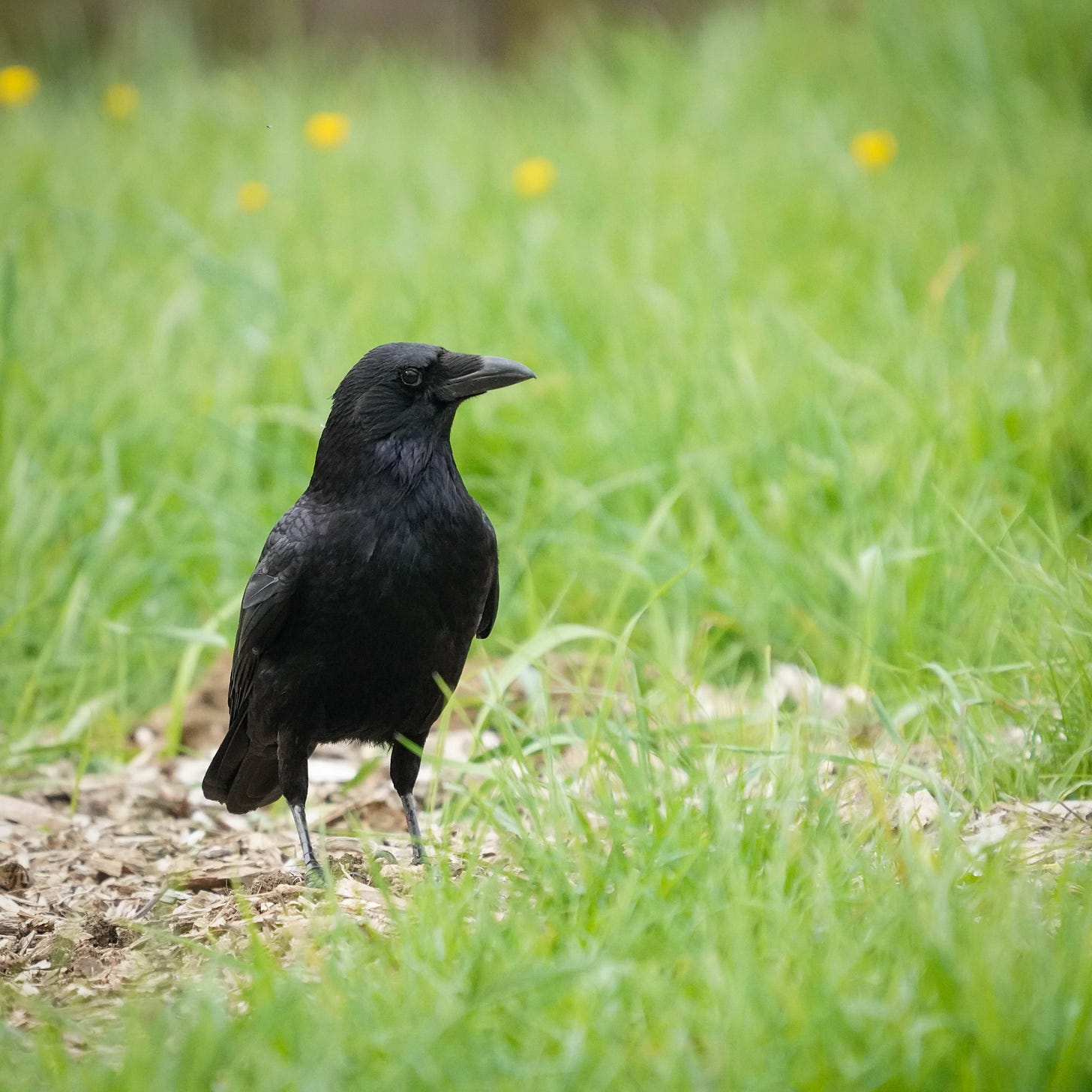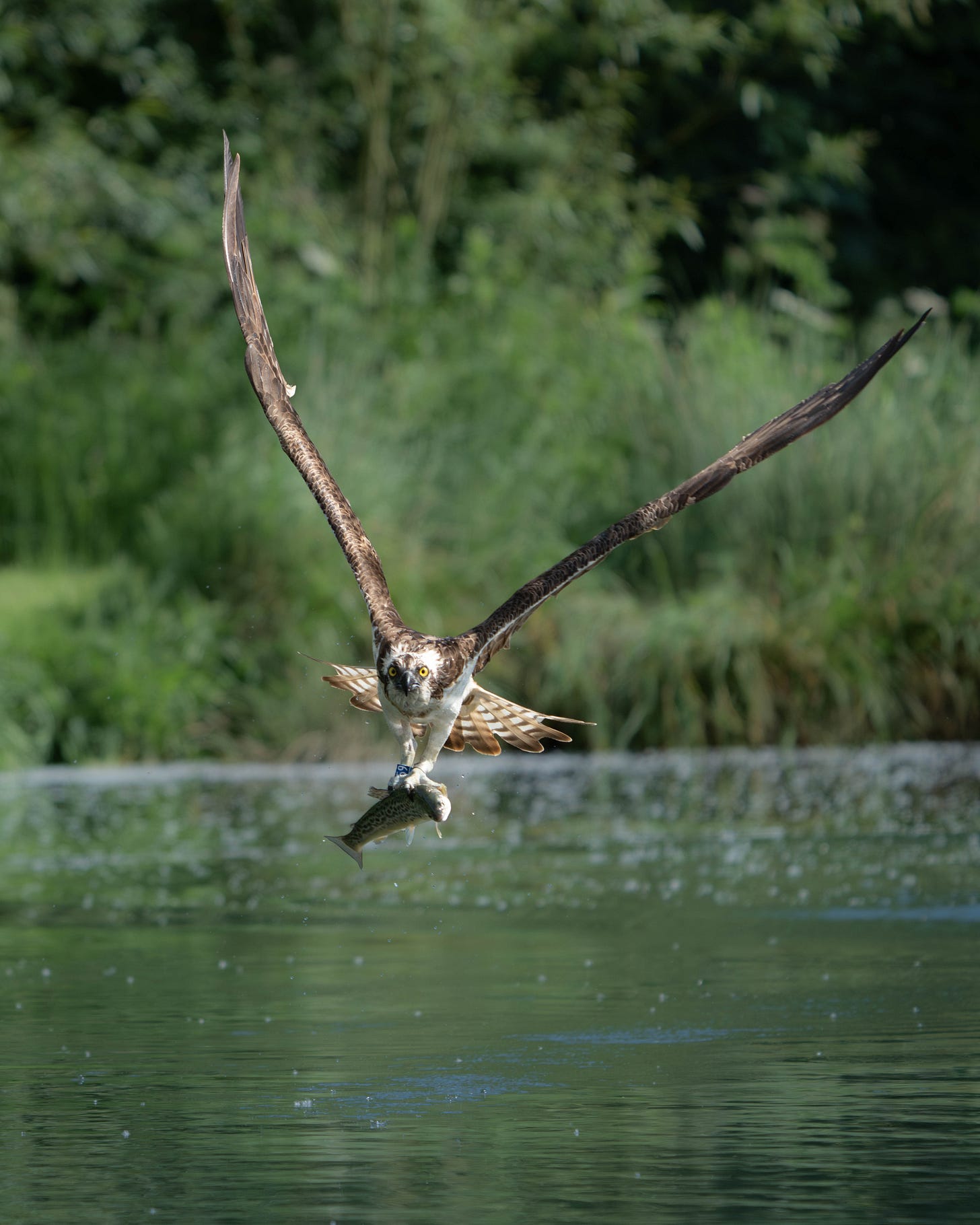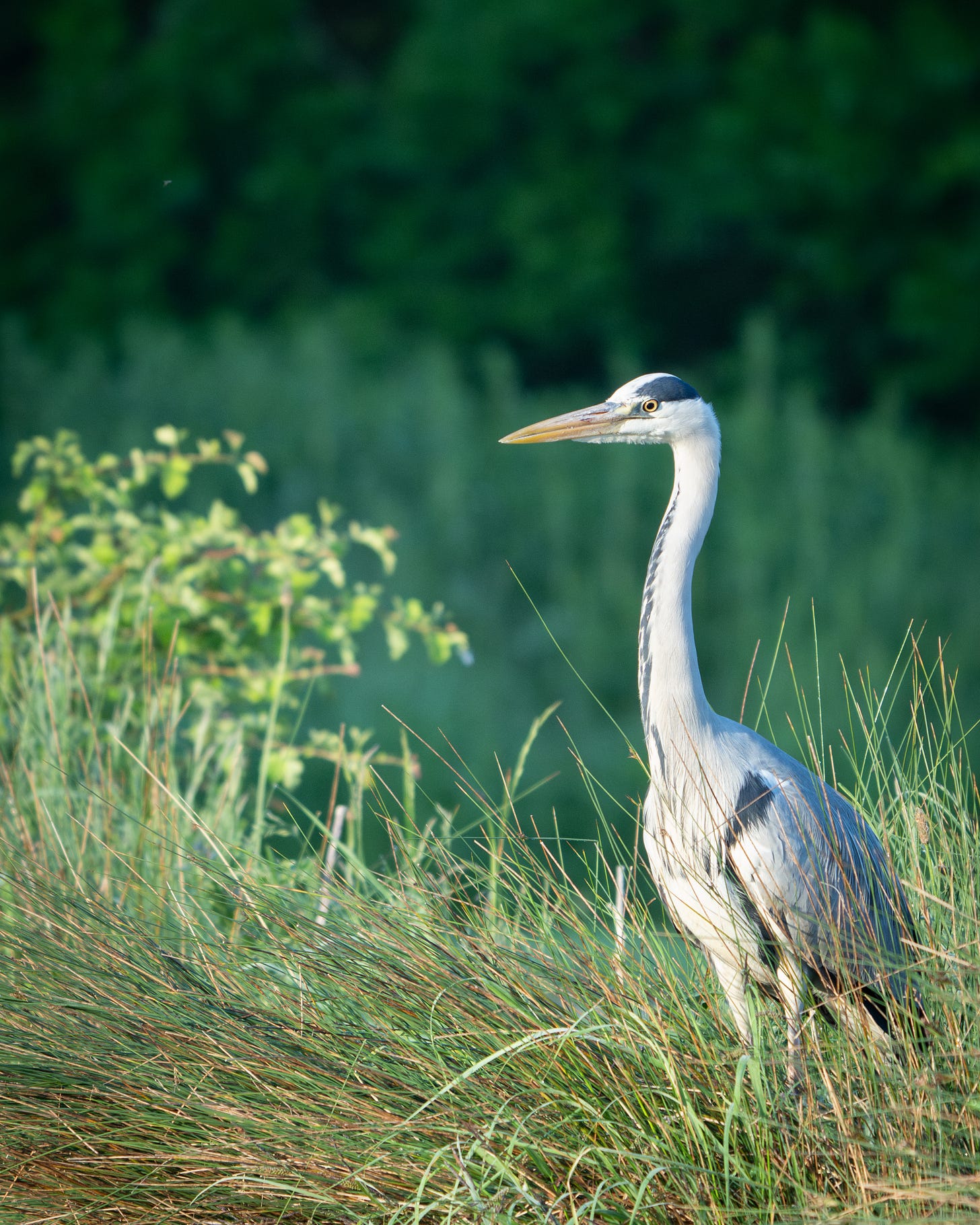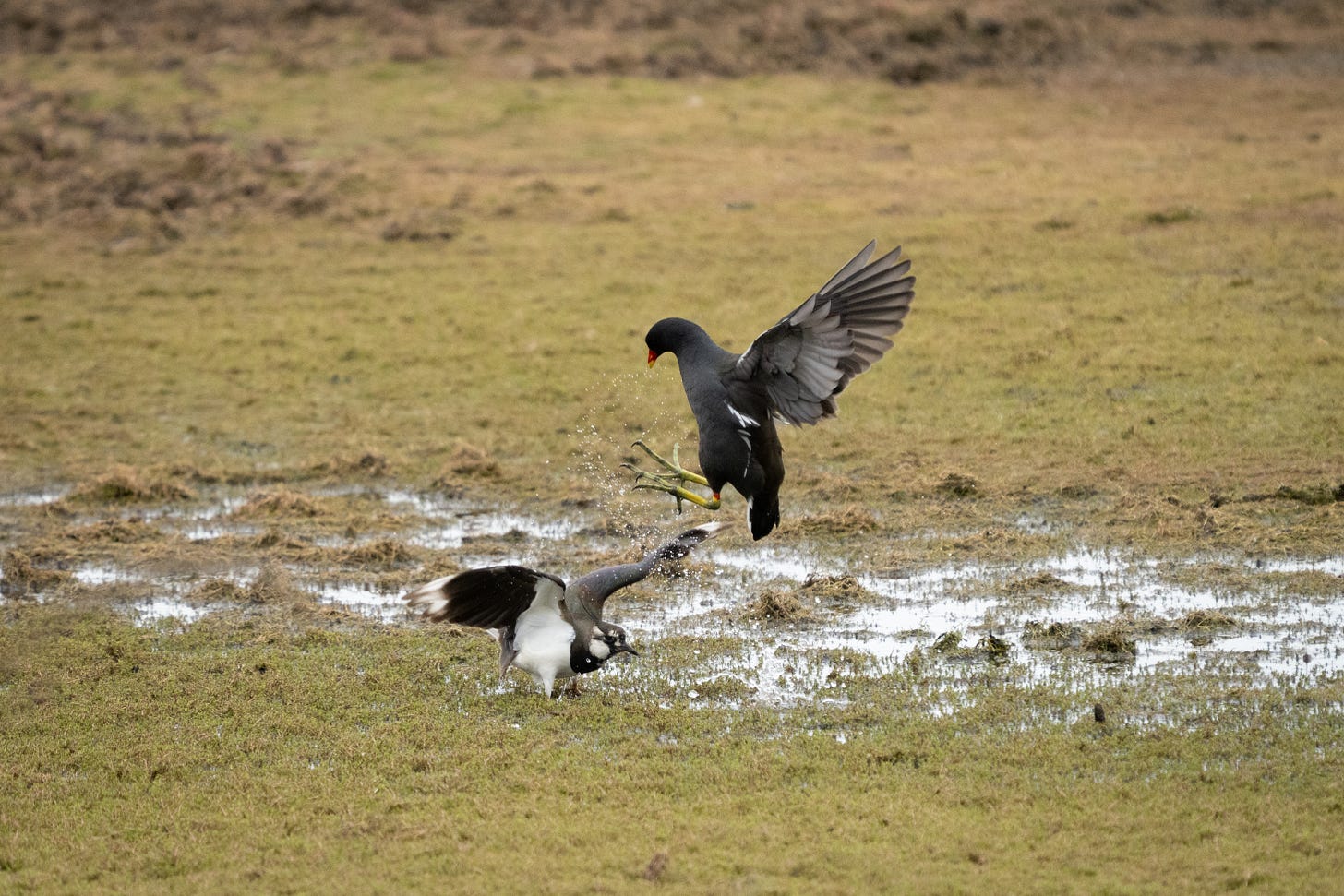This post has been migrated over from my original Substack account. This is its new home, so make sure you’re following me here to stay connected! Some images and other formatting may have been lost in the move – sorry about that.
At last, the rain has returned to my corner of the UK. The hedgerows and verges look to have doubled in size, with inches of light-coloured new growth appearing almost overnight.
Crow Chronicles
It has become increasingly difficult to spot Lovely, the local crow that follows me as I walk Jasper in the mornings. He’s still around, but his usual perches have been enveloped by leaves.
There are other ways to catch my eye, however. If I don’t spot him quickly enough, he swoops and flaps loudly in front of my face. And if that doesn’t work, he caws – indignantly – from his hidden location.
I eventually produce some snacks, and he stashes them in the field before catching back up with me. I’ve swapped ‘the odd dog treat’ for ‘a small handful of peanuts’ as I think it’s healthier for him. He stays at least a couple of metres away, which is how I prefer it. Taming wildlife is never a good idea, however tempting it may be.

Lovely has yet to bring me a gift, as I hear they sometimes do. And he certainly hasn’t told all his crow friends about me. He doesn’t seem to have any friends, actually. I’ve not seen him interact with other crows except when he follows me a little too far onto a nesting pair’s patch. They’re certainly not his friends.
How do you sex a crow? I wish I could enlighten you, but even measurements (wing length, head-to-bill ratio) aren’t entirely reliable methods.
Fish-eating friends
If you live near a large body of water that is home to Ospreys during the summer nesting season, this is a fantastic time to visit. Their eggs should be hatching over the coming weeks, so fishing will become a top priority. Ospreys are mainly found in North Wales, the very north of England and particularly in Scotland.
But here in central England we do have a stronghold around Rutland. A walk around the reservoir or RSPB reserve should provide you with plenty of opportunity to see these spectacular birds. The reservoir has a paved route around at least part of it, making it very accessible (provided you don’t mind the sheep that wander nervously between groups of visitors). Binoculars will help you distinguish between the Ospreys and Black-Backed Gulls that also soar high over the water.

Ospreys diverged onto their own branch of the family tree far earlier than any other birds of prey. They have a fascinating range of adaptations to help them hunt fish.
They can see ultraviolet light (plus the range of visible light we can see).
They have dark feathers around their eyes to reduce the glare of sunlight on water.
They can estimate how deep down a fish is and accurately compensate for how the light bends the image at that depth, allowing them to adjust their dive.
They can bend one of their toes on each foot backwards to help them grasp fish, while all other birds of prey have three forward facing toes and one backward facing one.
They also live on every continent except Antarctica. It seems those adaptations are extremely effective – some older birds have a fishing success rate of 90%. You can find out lots more about these remarkable birds from the Wildlife Trust.
If you can’t get to an Osprey location, there is another fascinating fish-eater you can find on most rural waterways: the heron (okay bear with me, they’re genuinely very cool).

These birds will eat anything they can get their beak on. Fish, yes – but also small mammals, other birds, amphibians and reptiles. (Well… anything except a vegetable.)
While they will snack on most things, they were also once a favoured snack themselves. Herons featured on many a medieval banquet table (I have to wonder if they removed the legs first). They were also popular prey items for hunters with falcons. Oh and apparently “The fat of a heron killed at full moon was once believed to be a cure for rheumatism”.
For some reason, these enormous and otherwise-solitary birds come together to nest in ‘heronries’ that can be over 100 strong. Multiple pairs will nest in the same tall tree.
If you happen to disturb a heronry by passing underneath it, you might end up wearing several herons’ recent meals, as they defend themselves with regurgitation. They can reach 1m tall, with a wingspan of double that – so it’s probably best to avoid such an event.
Snack time
This time last year I was fortunate enough to spot a mammal I’ve never seen before. With fewer than 50 species of land mammal in the UK, this does not happen often! And the Water Shrew is not easy to find.
This little one was foraging in a little ditch at RSPB Rye Meads, and as far as I know there is no previous record of this species there. Staying mostly just below the surface of the water (and the duckweed), it looked more like a mole that slipped in!
According to the Wildlife Trust:
The water shrew is quite unusual among mammals because it has a venomous bite. The poison in its saliva is strong enough to immobilise frogs and small fish. It can tackle prey up to 60 times heavier than itself, including newts, frogs, crustaceans and snails.
Sadly, 60 times heavier than itself is still only a few hundred grams, so if a Heron spots one of these? Into the beak it goes!
Food that fights back
Another critter that herons predate on is Lapwing nestlings. Fortunately, despite their proximity (Lapwings often nest near large bodies of water), these devoted parents do not make it easy.
Also known as pee-wits or green plovers, Lapwings are some of the most aggressive parents in the bird world. They will take on any goose, coot, crow – raven! – or yes, heron.
And having seen their offspring, who can blame them? Look at it! Extremely cute.
A few days old, this chick is just a bundle of fluff and legs. So how on earth do the parents keep them safe? And especially when the chicks all insist on wandering off to forage in different directions?
First, they often band together in groups and will diligently sound the alarm at the first sight of a predator. That makes Lapwing colonies a pretty noisy place to be, because predators come in many shapes and sizes when the prey is so small.
And the alarm call? It sounds somewhere between a kazoo and a broken radio. As the adults start calling, the chicks run for cover, assisted by their incredible camouflage.
Any parents not protecting a huddle of chicks under their wings take to the air. Calling, wheeling and diving, they make the predator’s work unimaginably difficult.
And not only do the Lapwings often successfully persuade the predator to ‘eff off’, they usually keep pestering it until it has ‘effed all the way off’ and decided to go and hunt elsewhere.

These beautiful little birds are unfortunately declining in number. As a child, I’d watch huge flocks of them take off from fields full of poppies on my way to school. Now, both the poppies and the Lapwings are long gone. Rows of pesticided crops take their place.
Through my lens
If there’s a bird more likely to start a fight than a Lapwing… it’s a Coot. They will fight anything for any reason (or no reason).
These birds are so overlooked. You can find them everywhere and they’re not too shy to pose for a photoshoot. They have coy smiles and striking red eyes.
They’re also hilarious to watch. They spend hours going back and forth collecting sticks that are far too long for their nest, squabbling with each other along the way. And they frequently bite off more pondweed than they can chew.
Their babies are also hideous. I try not to use such harsh language about wildlife, but really.
And if you think that’s bad? Don’t Google what their feet look like. I know, I know, you’re already typing ‘Coot’s feet’ into the search bar, but don’t say I didn’t warn you!
Your turn
I’d love to hear what wildlife you’ve spotted out and about this week, and whether you think it might fit in a Heron’s beak.
And if this made you smile or you learned something new, a like or subscribe goes a long way.
P.S. I was made redundant in Feb (boo) so I’m now freelancing (yay!). If you know a purpose-led organisation that needs an experienced content writer, I’d love to meet them. And if they can make use of my Zoology degree and wildlife knowledge? Even better. Thank you!









